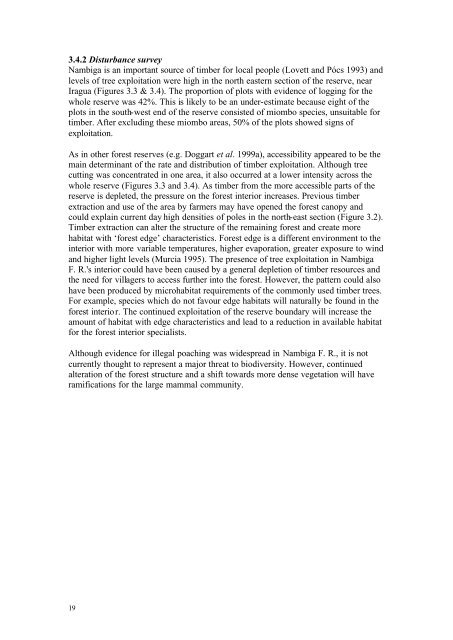Frontier Tanzania Savanna Research Programme
Frontier Tanzania Savanna Research Programme
Frontier Tanzania Savanna Research Programme
Create successful ePaper yourself
Turn your PDF publications into a flip-book with our unique Google optimized e-Paper software.
3.4.2 Disturbance surveyNambiga is an important source of timber for local people (Lovett and Pócs 1993) andlevels of tree exploitation were high in the north eastern section of the reserve, nearIragua (Figures 3.3 & 3.4). The proportion of plots with evidence of logging for thewhole reserve was 42%. This is likely to be an under-estimate because eight of theplots in the south-west end of the reserve consisted of miombo species, unsuitable fortimber. After excluding these miombo areas, 50% of the plots showed signs ofexploitation.As in other forest reserves (e.g. Doggart et al. 1999a), accessibility appeared to be themain determinant of the rate and distribution of timber exploitation. Although treecutting was concentrated in one area, it also occurred at a lower intensity across thewhole reserve (Figures 3.3 and 3.4). As timber from the more accessible parts of thereserve is depleted, the pressure on the forest interior increases. Previous timberextraction and use of the area by farmers may have opened the forest canopy andcould explain current day high densities of poles in the north-east section (Figure 3.2).Timber extraction can alter the structure of the remaining forest and create morehabitat with ‘forest edge’ characteristics. Forest edge is a different environment to theinterior with more variable temperatures, higher evaporation, greater exposure to windand higher light levels (Murcia 1995). The presence of tree exploitation in NambigaF. R.'s interior could have been caused by a general depletion of timber resources andthe need for villagers to access further into the forest. However, the pattern could alsohave been produced by microhabitat requirements of the commonly used timber trees.For example, species which do not favour edge habitats will naturally be found in theforest interior. The continued exploitation of the reserve boundary will increase theamount of habitat with edge characteristics and lead to a reduction in available habitatfor the forest interior specialists.Although evidence for illegal poaching was widespread in Nambiga F. R., it is notcurrently thought to represent a major threat to biodiversity. However, continuedalteration of the forest structure and a shift towards more dense vegetation will haveramifications for the large mammal community.19
















